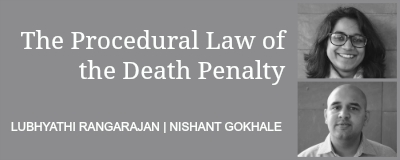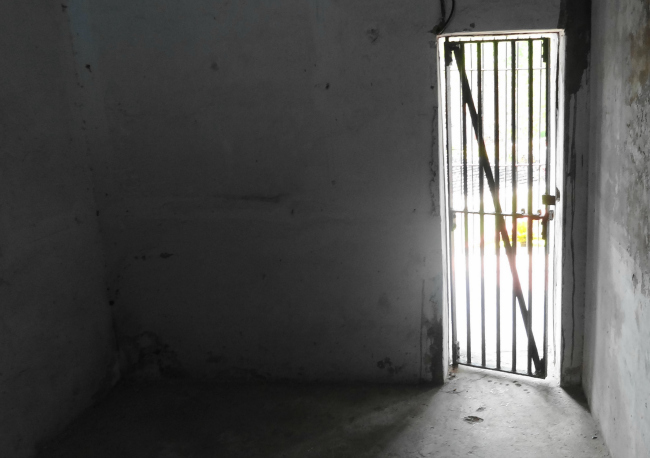 The death penalty was the norm and life imprisonment, the exception, under the Code of Criminal Procedure, 1898. Its replacement, the Code of Criminal Procedure, 1973(“CrPC”), reversed that position. Life imprisonment became the norm. The death penalty could only be awarded in exceptional cases, for which the court would have to record “special reasons”. In 1980, the Supreme Court took the law further down this path. After Bachan Singh v. State of Punjab, the death penalty could only be applied in the “rarest of the rare” cases and that too only “when the alternative option is unquestionably foreclosed”. What are these alternative options?
The death penalty was the norm and life imprisonment, the exception, under the Code of Criminal Procedure, 1898. Its replacement, the Code of Criminal Procedure, 1973(“CrPC”), reversed that position. Life imprisonment became the norm. The death penalty could only be awarded in exceptional cases, for which the court would have to record “special reasons”. In 1980, the Supreme Court took the law further down this path. After Bachan Singh v. State of Punjab, the death penalty could only be applied in the “rarest of the rare” cases and that too only “when the alternative option is unquestionably foreclosed”. What are these alternative options?
For nearly all punishments where the death sentence is prescribed, the Indian Penal Code, 1860 prescribes life imprisonment as an alternative. The meaning of ‘life imprisonment’ however, is not really clear. A brief survey of the Supreme Court’s jurisprudence on how the term has been understood raises a number of problems.
What is “life”?
It was settled in the case of Gopal Godse v. State of Maharashtra (1961) that life imprisonment meant imprisonment for one’s whole life. The power to remit this sentence was entirely within the executive domain. Then in 1978, Parliament enacted Section 433-A into the CrPC to mandate that a term of life imprisonment would be for a minimum of 14 years.
The constitutionality of this provision was assailed in Maru Ram’s Case (1980) by several petitioners including many convicts who were hopeful of release through remissions earned in prison or by the commutation of their sentence by state governments. The Supreme Court upheld its constitutionality. The Court noticed some startling instances of prisoners sentenced to life imprisonment being released for whimsical reasons such as a politician’s birthday or a minister visiting the jail and observed that while it could not find any particular logic why a period of 14 years was specified, it agreed, in deference to the legislature, that without Section 433-A, there was nothing to prevent persons convicted of serious offences from walking out of prison the very next day on account of their sentence being commuted by the state government.
The question of an appropriate alternative sentence arose again in Swamy Shraddananda’s Case (2008). In an appeal from a death sentence to the Supreme Court, Justice S.B. Sinha favoured life imprisonment whereas Justice Katju favoured the death penalty. The case was referred to a larger bench. A three-judge bench of the Court observed that in some cases, a sentence of 14 years was too mild and would amount to no punishment at all whereas the death penalty would seem too harsh. The Court was of the view that judges would be nudged to award the death sentence if there was nothing available to them between these two punishments. The Court therefore held that it had the power, in the case of a prisoner sentenced to life imprisonment, to direct that the prisoner would not be released from prison, either for the rest of his life, or for a duration specified by the court. Following this decision, the Supreme Court has awarded life imprisonment without parole for periods between 25 and 30 years in lieu of the sentence of death. The correctness of the decision of the court in Swamy Shraddananda’s Case is being considered by a constitution bench of the Supreme Court in Union of India v. V. Sriharan. It will question whether courts can place sentencing in some cases beyond the executive’s reach. Judgment has been reserved and is awaited.
The Court’s penological experimentation does not seem to have stopped there. In Subhash Chander’s Case (2001), a convict was spared the death sentence by the Supreme Court on his counsel making a submission that the prisoner would spend the rest of his life in prison without applying for pre-mature release or commutation. In Shankar KisanraoKhade’s Case (2013), the Court, while questioning the application of the death penalty and asking the Law Commission to examine the question, directed that the prisoner should serve two life sentences consecutively, rather than concurrently, as is the norm, and overturned the High Court’s recommendation for the award of the death penalty.
No consistent understanding of what is meant by “life imprisonment”
After the Criminal Law (Amendment) Act 2013, for the first time the Indian Penal Code prescribed sentences for one’s “whole life” for some types of aggravated sexual assault. It is important to note however, that there was no amendment to the general meaning of “life imprisonment” in the Indian Penal Code. Nor was there any clarification as to whether these whole life sentences would be beyond executive remission.
There is thus no coherent or consistent understanding about the meaning of the term “life imprisonment”. Alternatives to the death penalty should be explored, especially in light of the 262nd Law Commission Report, which found that the “rarest of the rare” principle has been arbitrarily applied. The alternative punishment to the death sentence, in its present form, seems to suffer similarly from arbitrariness and capriciousness.
It is important that there is consistency in handing out sentences of life imprisonment. Courts are, after all, dealing with human lives and these decisions cannot be taken lightly. There are no parameters at present to judge when a person should be awarded life imprisonment without parole for 30 years or life imprisonment simpliciter, or when life sentences awarded are to run consecutively instead of concurrently. The entire process is judge-centric and is subjective to such a high degree that it is not sustainable for a fair criminal justice system. The legislature and the judiciary should take note of these problems with the alternatives available to awarding the death penalty and work towards making them more viable.
(Nishant Gokhale and Lubhyathi Rangarajan are Associates at the Death Penalty Litigation Clinic, National Law University, Delhi.)

